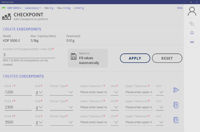Yodify Product Library
Add the SET-11 Software to your store or catalog
Book Your Demo and See How
or create your store
SET-11 Software
Brand: KernET Safety – Precision & Safety function.
Features- Note: the required basis is SET-01 ET OS (basic package)
- The Precision & Safety function is used for safe operation of a balance as measuring devices in critical and risky processes, such as, for example in the manufacture of pharmaceutical products, foodstuffs, cosmetics and other products
- When it matters, whether a specific balance can even be used as a measuring device, or when you need to guarantee that the balance is always in perfect working order from a metrological point of view, then the EasyTouch Precision & Safety function offers a range of tools to definitively guarantee this security
- Checkpoint function – test points: This function enables you to determine defined test points for any balance (even those made by other manufacturers). These test points always relate to a specified nominal load (e.g. 100.0 g). One test point or several test points can be created for each balance. If required, the system suggests automatically calculated test points. For each inspection point, a specific, permissible tolerance can be defined with an upper and lower limit value
- Checkpoint function – time interval: This function allows you to define specific time intervals for each balance, after which an obligatory check of the defined test points must be carried out. In this way, for example, several checks per day at specific times or one check per week can be defined. E.g. daily, every morning at 8.00 am, etc.
- Checkpoint function – test weights: With this function, you can assign certain test weights to the relevant test points. By storing particular test weights the user can be shown which test weight is to be used for which test point. On selection of the weights, the system automatically ensures that only those test weights can be selected where the permitted OIML tolerance of these weights are smaller than the permitted tolerance of that particular test point
- Checkpoint function – calibrated test weights: With this you can store possible calibration data for the test weights which have been entered. Specifically, a calibration interval and the date of the last calibration as well as the conventional mass of the test weight of the last calibration can be stored
- Checkpoint function – testing and consequences: This allows a balance for which the checkpoint function is activated to be fully used as long as all checkpoint tests are successful. If a test is not successful, the balance is blocked, i.e. no more data can be stored or printed from this balance. A test counts as not being successful if the display in one or more checkpoints is outside the permitted tolerance, if the calibration intervals from one or more test weights have expired and has not been renewed. If the conventional mass of one or more test weights is found to be outside the permitted OIML tolerance, then the system requests that these weights are replaced for the relevant checkpoints
- Adjustment testing: Doing this means that a separate adjusting interval can be assigned to each balance – depending on the risk analysis. EasyTouch Precision & Safety prompts the user to adjust the balance in good time. If the user does not positively confirm the adjustment, then the data storage function on the balance is blocked
- Activation of a balance after it has been blocked: This option exists for a specific user group (e.g. Lab. Supervisor), after the test in question has been carried out with a successful result
- Temporary suppression of pending tests can be allowed via an administrator setting. However, for a maximum of 30 minutes after the due date, to ensure that an operation is ended properly
- Minimum weight testing: This function enables you to manually store an individual minimum weight for each balance Whenever the weighing result is below the minimum weight, the scale remains blocked
- Calibration and verification testing: In this function a verification period and a calibration period can be created and maintained for each balance. If this period expires without the calibration or verification being refreshed, the scale remains blocked
- Level testing: With this function, an optical check of the levelling of the device can be requested for each scale. The user is thus requested to confirm the perfect leveling status of the balance at predefined times, the scale remains blocked
- ISO protocol: The ISO protocol can be selected for each active balance. In this protocol, the precise state of the balance can be output - at the point in time when the printout was created. In this protocol the user has an immediate overview of the verification and calibration state of the balance, the checkpoint tests, the individual minimum load and the last level check
- Watch the product film - https://youtu.be/XZldVTbCBcQ
- Technical data
- Licensing: One license can be operated on up to four terminal devices (PC, laptop, tablet) at the same time, working independently
- User: You can store as many users as you need in one license
- Balances: You can store and operate as many balances as you need in one license
- Communication balances-terminal device: The balance(s) can communicate using serial connections, USB, Bluetooth, Ethernet or WiFi with the PC, laptop or tablet









